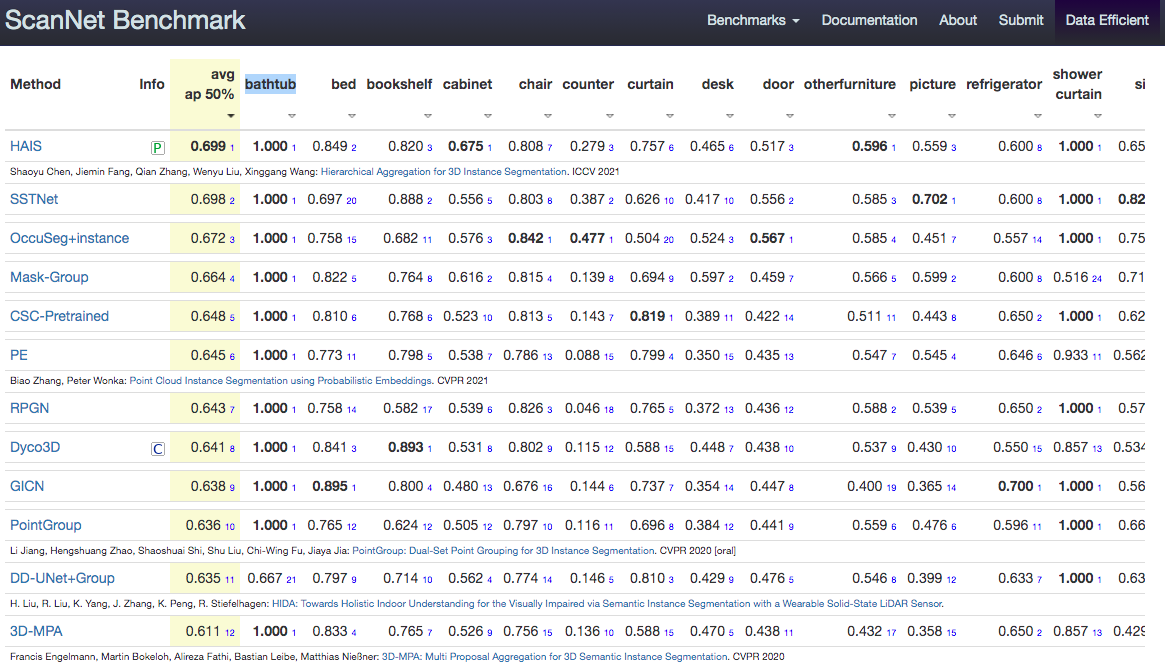by Shaoyu Chen, Jiemin Fang, Qian Zhang, Wenyu Liu, Xinggang Wang*. (*) Corresponding author. [arXiv]
- HAIS is an efficient and concise bottom-up framework (NMS-free and single-forward) for point cloud instance segmentation. It adopts the hierarchical aggregation (point aggregation and set aggregation) to generate instances and the intra-instance prediction for outlier filtering and mask quality scoring.
- High performance. HAIS ranks 1st on the ScanNet benchmark (Aug. 8th, 2021).
- High speed. Thanks to the NMS-free and single-forward inference design, HAIS achieves the best inference speed among all existing methods. HAIS only takes 206 ms on RTX 3090 and 339 ms on TITAN X.
| Method | Per-frame latency on TITAN X |
|---|---|
| ASIS | 181913 ms |
| SGPN | 158439 ms |
| 3D-SIS | 124490 ms |
| GSPN | 12702 ms |
| 3D-BoNet | 9202 ms |
| GICN | 8615 ms |
| OccuSeg | 1904 ms |
| PointGroup | 452 ms |
| HAIS | 339 ms |
- Code is released.
- With better CUDA optimization, HAIS now only takes 339 ms on TITAN X, much better than the latency reported in the paper (410 ms on TITAN X).
1) Environment
- Python 3.x
- Pytorch 1.1 or higher
- CUDA 9.2 or higher
- gcc-5.4 or higher
Create a conda virtual environment and activate it.
conda create -n hais python=3.7
conda activate hais
2) Clone the repository.
git clone https://github.com/hustvl/HAIS.git --recursive
3) Install the requirements.
cd HAIS
pip install -r requirements.txt
conda install -c bioconda google-sparsehash
4) Install spconv
-
Verify the version of spconv.
spconv 1.0, compatible with CUDA < 11 and pytorch < 1.5, is already recursively cloned in
HAIS/lib/spconvin step 2) by default.For higher version CUDA and pytorch, spconv 1.2 is suggested. Replace
HAIS/lib/spconvwith this fork of spconv.
git clone https://github.com/outsidercsy/spconv.git --recursive
Note: In the provided spconv 1.0 and 1.2, spconv\spconv\functional.py is modified to make grad_output contiguous. Make sure you use the modified spconv but not the original one. Or there would be some bugs of optimization.
- Install the dependent libraries.
conda install libboost
conda install -c daleydeng gcc-5 # (optional, install gcc-5.4 in conda env)
- Compile the spconv library.
cd HAIS/lib/spconv
python setup.py bdist_wheel
- Intall the generated .whl file.
cd HAIS/lib/spconv/dist
pip install {wheel_file_name}.whl
5) Compile the external C++ and CUDA ops.
cd HAIS/lib/hais_ops
export CPLUS_INCLUDE_PATH={conda_env_path}/hais/include:$CPLUS_INCLUDE_PATH
python setup.py build_ext develop
{conda_env_path} is the location of the created conda environment, e.g., /anaconda3/envs.
1) Download the ScanNet v2 dataset.
2) Put the data in the corresponding folders.
-
Copy the files
[scene_id]_vh_clean_2.ply,[scene_id]_vh_clean_2.labels.ply,[scene_id]_vh_clean_2.0.010000.segs.jsonand[scene_id].aggregation.jsoninto thedataset/scannetv2/trainanddataset/scannetv2/valfolders according to the ScanNet v2 train/val split. -
Copy the files
[scene_id]_vh_clean_2.plyinto thedataset/scannetv2/testfolder according to the ScanNet v2 test split. -
Put the file
scannetv2-labels.combined.tsvin thedataset/scannetv2folder.
The dataset files are organized as follows.
HAIS
├── dataset
│ ├── scannetv2
│ │ ├── train
│ │ │ ├── [scene_id]_vh_clean_2.ply & [scene_id]_vh_clean_2.labels.ply & [scene_id]_vh_clean_2.0.010000.segs.json & [scene_id].aggregation.json
│ │ ├── val
│ │ │ ├── [scene_id]_vh_clean_2.ply & [scene_id]_vh_clean_2.labels.ply & [scene_id]_vh_clean_2.0.010000.segs.json & [scene_id].aggregation.json
│ │ ├── test
│ │ │ ├── [scene_id]_vh_clean_2.ply
│ │ ├── scannetv2-labels.combined.tsv
3) Generate input files [scene_id]_inst_nostuff.pth for instance segmentation.
cd HAIS/dataset/scannetv2
python prepare_data_inst.py --data_split train
python prepare_data_inst.py --data_split val
python prepare_data_inst.py --data_split test
CUDA_VISIBLE_DEVICES=0 python train.py --config config/hais_run1_scannet.yaml
1) To evaluate on validation set,
- prepare the
.txtinstance ground-truth files as the following.
cd dataset/scannetv2
python prepare_data_inst_gttxt.py
-
set
splitandevalin the config file asvalandTrue. -
Run the inference and evaluation code.
CUDA_VISIBLE_DEVICES=0 python test.py --config config/hais_run1_scannet.yaml --pretrain $PATH_TO_PRETRAIN_MODEL$
Pretrained model: Google Drive / Baidu Cloud [code: sh4t]. mAP/mAP50/mAP25 is 44.1/64.4/75.7.
2) To evaluate on test set,
- Set (
split,eval,save_instance) as (test,False,True). - Run the inference code. Prediction results are saved in
HAIS/expby default.
CUDA_VISIBLE_DEVICES=0 python test.py --config config/hais_run1_scannet.yaml --pretrain $PATH_TO_PRETRAIN_MODEL$
- Transform the prediction results into the submission format.
- Submit the results to the official evaluation server.
We provide visualization tools based on Open3D (tested on Open3D 0.8.0).
pip install open3D==0.8.0
python visualize_open3d.py --data_path {} --prediction_path {} --data_split {} --room_name {} --task {}
Please refer to visualize_open3d.py for more details.
The code is based on PointGroup and spconv.
If you have any questions or suggestions about this repo, please feel free to contact me (shaoyuchen@hust.edu.cn).
@InProceedings{Chen_2021_ICCV,
author = {Chen, Shaoyu and Fang, Jiemin and Zhang, Qian and Liu, Wenyu and Wang, Xinggang},
title = {Hierarchical Aggregation for 3D Instance Segmentation},
booktitle = {Proceedings of the IEEE/CVF International Conference on Computer Vision (ICCV)},
month = {October},
year = {2021},
pages = {15467-15476}
}





